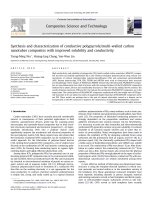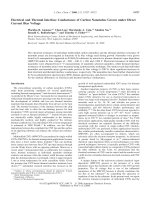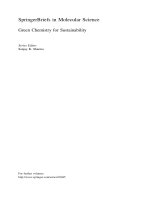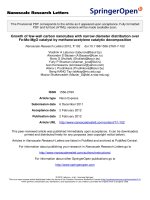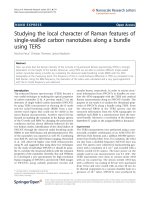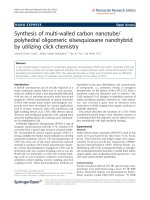conducting polymer functionalized multi walled carbon nanotubes with
Bạn đang xem bản rút gọn của tài liệu. Xem và tải ngay bản đầy đủ của tài liệu tại đây (1.89 MB, 9 trang )
Please cite this article in press as: K.R. Reddy, et al., Synthetic Met. (2009), doi:10.1016/j.synthmet.2008.11.030
ARTICLE IN PRESS
G Model
SYNMET-12389; No.of Pages9
Synthetic Metals xxx (2009) xxx–xxx
Contents lists available at ScienceDirect
Synthetic Metals
journal homepage: www.elsevier.com/locate/synmet
Conducting polymer functionalized multi-walled carbon nanotubes with
noble metal nanoparticles: Synthesis, morphological characteristics and
electrical properties
Kakarla Raghava Reddy
a
, Byung Cheol Sin
a
, Kwang Sun Ryu
a
, Jin-Chun Kim
b
,
Hoeil Chung
c
, Youngil Lee
a,∗
a
Department of Chemistry, University of Ulsan, Moogeo-dong Nam-gu, Ulsan 680-749, Republic of Korea
b
School of Materials Science and Engineering, University of Ulsan, Ulsan 680-749, Republic of Korea
c
Department of Chemistry, Hangyang University, Seoul 133-791, Republic of Korea
article info
Article history:
Received 18 June 2008
Received in revised form 3 November 2008
Accepted 28 November 20 08
Available online xxx
Keywords:
Carbon nanotubes
Conducting polymer
Metal nanoparticles
Nanocomposites
Functionalization
abstract
We report the synthesis of conducting polyaniline-functionalized multi-walled carbon nanotubes
(MWCNTs-f-PANI) containing noble metal (Au and Ag) nanoparticles composites (MWCNTs-f-PANI-Au
or Ag-NC). MWCNTs-f-PANI was initially synthesized by functionalizing acyl chloride terminated carbon
nanotubes (MWCNTs-COCl) with 2,5-diaminobenzenesulphonic acid (DABSA) via amide bond formation,
followed by surface initiated in situ chemical oxidative graft polymerization of aniline in the presence
of the ammonium persulphate (APS) as an oxidizing agent. MWCNTs-f-PANI was then dispersed into
an aqueous Au or Ag metal salt solution followed by the addition of sodium citrate, which acted as a
reducing agent. The resulting composite contained a high level of well dispersed Au or Ag nanoparti-
cles (MWCNTs-f-PANI/Au-NC or MWCNTs-f-PANI-Ag-NC). Morphological and structural characteristics,
as well as electrical conducting properties of the hybrid nanocomposites were characterized using various
techniques including high resolution transmission electron microscopy (HRTEM), X-ray diffraction (XRD),
Fourier transform infrared spectroscopy (FT-IR), UV–visible spectroscopy (UV–vis) and four-probe mea-
surements. FT-IR spectra confirmed that PANI was covalently bonded to MWCNTs. TEM images revealed
the presence of Au or Ag nanoparticles finely dispersed in the composites with a size of <15 nm. XRD
analysis revealed the presence of strong interactions between the metal nanoparticles and MWCNTs-f-
PANI, where the metal particles were present in a phase-pure crystalline state with face centered cubic
(fcc) structure. The room temperature electrical conductivity of the MWNCTs-f-PANI/Au or A g compos-
ites was 4.8–5.0 S/cm, respectively, which was much higher than that of CNTs-f-PANI (0.18 S/cm) or pure
PANI (2.5 × 10
−3
S/cm). A plausible mechanism for the formation of nanocomposites is presented. We
expect that the new synthesis strategy reported here will be applicable for the synthesis of other hybrid
CNTs–polymer/metal nanocomposites with diverse functionalities. This new type of hybrid nanocom-
posite material may have numerous applications in nanotechnology, gas sensing, and catalysis.
Crown Copyright © 2008 Published by Elsevier B.V. All rights reserved.
1. Introduction
The discovery of carbon nanotubes (CNTs) by Iijima in 1991
has attracted scientific and technological interest worldwide. Both
multi-walled and single-walled carbon nanotubes (MWCNTs and
SWCNTs) have excellent chemical, thermal, and mechanical prop-
erties in terms of their stiffness, high Young’s modulus, flexibility,
and high electrical conductivity [1–4]; these properties can be
attributed to the high degree of organization and high aspect ratio
of CNTs. CNTs exhibit remarkable properties useful for construct-
∗
Corresponding author. Tel.: +82 52 259 2341; fax: +82 52 259 2348.
E-mail address: (Y. Lee).
ing nanoscale devices and developing multifunctional composite
materials [5,6]. However, owing to the rigidity, chemical inertness,
and strong – interactions of nanotubes, pure CNTs cannot be
processed, as they are difficult to dissolve or disperse in common
organic solvents or polymeric matrices. Therefore, the side walls
of CNTs must be chemically modified to improve their dispersion
or solubility in solvents or polymers [7–9]. Recently, the modifica-
tion of many materials utilizing CNTs has attracted considerable
interest, owing to the outstanding properties of CNTs [10–12].
Based on interactions b etween organic and inorganic materials in
such hybrids, a large number of new hybrid nanocomposite (NC)
materials with synergetic behaviors and potential applications in
electronic or nanoelectronic devices have been obtained. Of these
hybrids, CNT-conducting electroactive polymer (CEP) composites
0379-6779/$ – see front matter. Crown Copyright © 2008 Published by Elsevier B.V. All rights reserved.
doi:10.1016/j.synthmet.2008.11.030
Please cite this article in press as: K.R. Reddy, et al., Synthetic Met. (2009), doi:10.1016/j.synthmet.2008.11.030
ARTICLE IN PRESS
G Model
SYNMET-12389; No.of Pages9
2 K.R. Reddy et al. / Synthetic Metals xxx (2009) xxx–xxx
are one of the most important, based on their electron donor and
acceptor interactions.
Research on the precise control of synthesis of composite
nano-structures has become increasingly important as the func-
tionality, processability, size, and morphology of nano-structures
play a crucial role in the development of CEP-CNTs/metal hybrid
nanocomposites for potential applications as sensors, superca-
pacitors, electromagnetic interference shielding materials, and
catalysts [13–16]. Composites of CNTs with CEPs such as polyani-
line, polypyrrole, and polythiophene have been prepared by in
situ chemical polymerization, electro-polymerization or irradiation
methods [17–20]; however, composites synthesized using these
methods have several disadvantages including the tendency to
form aggregate granular shapes when CNTs are present in the
composite, lack of colloidal stability, and poor general character-
istics.
The interactions between CNTs and a CEPs matrix in the com-
posites prepared by above methods are electrostatic or physical
adsorption. So, it is easy to destroy such poor interactions between
them due to the absence of strong covalent bonds. Strong bond-
ing is essential to ensure efficient transfer from the CEP matrix to
the carbon nanotube lattice, and is thus one of the critical issues
currently related to CNTs–CEP composites. Given the importance
of such composites, methods need to be developed for the synthe-
sis of chemically functionalized CNTs–polymer composites before
they can used for technological applications. Specifically, chemical
functionalization leads to enhancement of both processability and
performance of the resulting composite material.
Many recent efforts have focused on the synthesis of CEPs with
metal and metal oxides (such as Fe
3
O
4
,TiO
2
, SiO
2
,V
2
O
5
, Cu, Pd, Ag
and Pt) because of their superior performance as rechargeable bat-
teries, nanodevices, hydrogen storage vessels, nonvolatile memory
units, and chemical and biological sensors, among others [21–26].
There are two general methods that used to synthesize CEPs-metal
nanoparticles composites, namely chemical (in situ/ex situ), and
electrochemical polymerization. In the in situ method, metal parti-
cles are incorporated within CEP matrix by the reduction of metallic
precursor ions; whereas ex situ method involves preparation of
metal nanoparticles at the first, followed by the dispersion into the
CEP matrix. The electrochemical method involves through incorpo-
ration of metal particles during the electrosynthesis of the polymer
or by the electrodeposition of metal particles on preobtained CEPs.
Polyaniline (PANI) is the most important CEP because of its low cost,
high polymerization yield, moderate electrical conductivity, good
environmental stability, mechanical flexibility, reversible acid/base
doping/dedoping nature, and its potential use in a large variety of
applications [27,28]. Notwithstanding, the conductivity and current
carrying capacity of PANI are lower compared to those of most met-
als; this deficit could be addressed by incorporating metal particles
into a polymer matrix.
Noble metal (such as Au and Ag)-containing nanoparticles have
received a great deal of attention due to their unique electrical, cat-
alytic, optical and sensing characteristics as well as their potential
use in a wide variety of applications ranging from optical and elec-
tronic nanodevices to biosensing and antimicrobial agents [29,30].
Composites of PANI and its derivatives with Au or Ag nanopar-
ticles have been synthesized via spontaneous redox reaction of
corresponding monomers with AuCl
3
or AgNO
3
using a one step
polymerization method where the monomer acts as reductant of
the metal ions [31,32]. The composite obtained by this method
has some disadvantages; for example, the binding between the
organic and inorganic counterparts is weak, control of size and
shape is difficult, and composite particles form heavy agglomerates.
Hence, dispersion of uniform metal nanoparticles into polymers
has become an important issue in the fabrication of desirable poly-
mer nanocomposites; however,despite their importance, reports of
hybrid composites with three components composed of chemically
functionalized CNTs with CEPs and well dispersed metal nanopar-
ticles are scarce.
In this article, we report a new strategy for the synthesis
of hybrid nanocomposites consisting of MWCNTs functional-
ized with PANI (MWCNTs-f-PANI) and noble metal (Au and Ag)
nanoparticles. Firstly, MWCNTs-f-PANI was prepared. For this
we modified the carbon nanotubes (MWCNTs-COCl) with DABSA
via amide linkage, and subsequently in situ chemical oxidative
graft polymerization of aniline was performed. Next, Au or Ag
nanoparticle-embedded MWCNTs-f-PANIwas prepared by dispers-
ing MWCNTs-f-PANI in an aqueous Au or Ag salt solution followed
by sodium citrate reduction. The resulting MWCNTs-f-PANI/Au or
MWCNTs-f-PANI/Ag nanocomposites were investigated in detail
using HRTEM, XRD, FT-IR, UV–vis and electrical conductivity mea-
surements. The synthesized hybrid composites possessed high
conductivity. The formation mechanism of the nanocomposites is
also presented.
2. Experimental
2.1. Materials
The MWCNTs used in this work were purchased from nano-
carbon Co., Ltd.Aniline, thionylchloride (SOCl
2
), 2,5-diaminobenze-
nesulphonic acid (DABSA), HAuCl
4
·H
2
O, AgNO
3
and ammonium
persulphate (APS) were obtained from Aldrich and were used as
received.
2.2. Chemical oxidation of MWCNTs
Typically, 1.0 g of crude MWCNTs were added to 150 mL of
HNO
3
:H
2
SO
4
(1:3, v/v) and sonicated for 4 h in an ultrasonic bath
(40 kHz); the resulting mixture was then transferred into a 500 mL
flask equipped with a condenser and was refluxed with vigorous
stirring at 90
◦
C for 9h. After cooling to room temperature the mix-
ture was subjected to vacuum filtration using a 0.2 m millipore
polycarbonate membrane filter that was then washed several times
with distilled water until the pH of the filtrate was 7.0. The filtered
solid was dried under vacuum for 24 h at 60
◦
CtogiveMWCNTs
functionalized with carboxylic acid (MWCNTs-COOH).
2.3. Acylation of MWCNTs
MWCNTs-COOH (125 mg), synthesized as describ ed above, was
reacted with 100 mL of SOCl
2
at 70
◦
C for 24 h under reflux to con-
vert the surface-bound carboxylic acid groups into acyl chloride
groups. Any residual SOCl
2
was removed by rotary evaporation,
and the solids that were subsequently obtained were filtered
and washed with anhydrous THF. Lastly, the filtrate was dried
under vacuum at room temperature for 4 h to give acyl chloride-
functionalized MWCNTs (MWCNTs-COCl).
2.4. Synthesis of PANI functionalized MWCNTs composites
(MWCNTs-f-PANI)
MWCNTs-COCl was reacted with DABSA under reflux in THF sol-
vent at 60
◦
C for 48 h under a nitrogen atmosphere. The products
were then separated by centrifugation, washed well with methanol,
and dried under vacuum at room temperature. The resultant prod-
uct was designated MWCNTs-DABSA.
The synthesis procedure of MWCNTs-f-PANI was as follows:
MWCNTs-DABSA was dispersed in 20 mL of a 0.5 M HCl containing
2.7 mmol of anilineand stirred under ultrasonication conditions for
15 min. Next, 10 mL of APS solution (0.5 g) was added dropwise to
the above mixture and the reaction was allowed to continue while
Please cite this article in press as: K.R. Reddy, et al., Synthetic Met. (2009), doi:10.1016/j.synthmet.2008.11.030
ARTICLE IN PRESS
G Model
SYNMET-12389; No.of Pages9
K.R. Reddy et al. / Synthetic Metals xxx (2009) xxx–xxx 3
stirring at room temperature for 12 h. Unwanted byproducts in the
precipitate were removed by washing with an excess of distilled
water and methanol until the filtrate was colorless; the resulting
filtrate was then dried under vacuum. The nanocomposite obtained
was designated MWCNTs-f-PANI. For comparativepurpose, pristine
PANI was synthesized using theMWCNTs-f-PANI synthesis protocol
but without using MWCNTs-DABSA.
2.5. Dispersion of Au or Ag nanoparticles into PANI functionalized
carbon nanotubes (MWCNTs-f-PANI/Au or Ag-NC)
In a typical procedure, MWCNTs-f-PANI was dispersed in 40 mL
of twice-distilled water containing 1 wt.% of HAuCl
4
·H
2
O and
sonicated for 20 min. This mixture was then transferred to a round-
bottom flask and heated to boiling while stirring, after which a
1 mL solution of sodium citrate was added, and ultrasonic stir-
ring was continued for an additional 30 min. After the reaction was
complete, the product, which was designated MWCNTs-f-PANI/Au-
NC, was collected by centrifugation and dried overnight at 50
◦
C
under vacuum. A similar procedure was followed for synthesis of
MWCNTs-f-PANI/Ag-NC using AgNO
3
instead of HAuCl
4
·H
2
O.
2.6. Characterization
Fine powdered samples were characterized using several tech-
niques. High resolution transmission electron microscopy (HRTEM)
studies were carried out with a Hitachi HF-2000 with an accelerat-
ing voltage of 200 kV. The sample was initially dispersed in ethanol
by ultrasonication for 5 min. Afterwards, a drop of the suspension
was transferred onto a carbon coated copper grid and mounted
on the microscope, and the micrographs were recorded. Fourier
transform infrared (FT-IR) spectra of the samples were obtained
using a Bruker IFS 66v Fourier transform infrared spectrometer.
UV–visible spectra were obtained using a Beckman UV–visible (DU
7500) spectrophotometer with a scanning speed of 200 nm/min
and bandwidth of 0.1nm. Wide-angle X-ray diffractograms (WAXD)
were obtained on a Rigaku Geiger Flex D-Max III, using Ni-filtered
Cu K␣ radiation (40 kV, 15 mA) and a scanning rate of 0.05
◦
/min.
Fig. 1. Low and high magnification HRTEM images of the (a and b) oxidized MWCNTs; (c–e) MWCNTs-f-PANI.
Please cite this article in press as: K.R. Reddy, et al., Synthetic Met. (2009), doi:10.1016/j.synthmet.2008.11.030
ARTICLE IN PRESS
G Model
SYNMET-12389; No.of Pages9
4 K.R. Reddy et al. / Synthetic Metals xxx (2009) xxx–xxx
The room temperature electrical conductivity of the polymers and
composites were measured using a standard Van Der Pauw dc four-
probe method [33].
3. Results and discussion
3.1. Morphology and formation of the MWCNTs-f-PANI/Au or Ag
nanocomposites
The morphology and size of the as-oxidized MWCNTs,MWCNTs-
f-PANI and MWCNTs-PANI/Au or Ag composites were investigated
by HRTEM. Fig. 1a shows that after treatment of MWCNTs with mix-
tures of HNO
3
and H
2
SO
4
under reflux, the nanotubes were opened,
oxidized and shortened, and exhibited regular morphology. The
nanotube dimensions were several hundred nanometers in length
and 15–25nm in diameter. As shown in Fig. 1c, MWCNTs were cov-
ered by PANI, indicating that the polymer was attached strongly to
Fig. 2. (a and b) Low and high magnification HRTEM images of the MWCNTs-f-
PANI/Au composites.
Fig. 3. (a and b) Low and high magnification HRTEM images of the MWCNTs-f-
PANI/Ag composites.
the CNTs. The difference between the high magnification HRTEM
images of the purified CNTs (Fig. 1b) and MWCNTs-f-PANI (Fig. 1d
and e) also clearly indicates that the carbon nanotubes were encap-
sulated by ordered PANI chains. In addition, it can be clearly seen
from Figs. 2 and 3 that the 10–15nm size of the metal (Au and Ag)
nanoparticles were uniformly and individually distributed in the
MWCNTs-f-PANI composite.
The mechanism of MWCNTs-f-PANI/Au or Ag nanocomposite
formation is shown in Scheme 1 and comprises the following
steps: (i) purification and oxidation of pristine MWCNTs, (ii) con-
version of MWCNTs to MWCNTs-COCl by reacting oxidized CNTs
with acyl chloride, (iii) reaction of MWCNTs-COCl with DABSA via
amide functionality, iv) reaction ofactive –NH
2
sites with an aniline
monomer-oxidant solution to produce MWCNTs-f-PANI, and lastly,
(v) dispersion of Au or Ag nanoparticles into MWCNTs-f-PANI.
It is well known that pure CNTs have both poor solubility and
dispersibility, traits that result in their tendency to bundle up
easily because of strong inter-tube van der Waals interactions. Like-
Please cite this article in press as: K.R. Reddy, et al., Synthetic Met. (2009), doi:10.1016/j.synthmet.2008.11.030
ARTICLE IN PRESS
G Model
SYNMET-12389; No.of Pages9
K.R. Reddy et al. / Synthetic Metals xxx (2009) xxx–xxx 5
wise, hydrophobic interactions in aqueous solutions tend to retard
alignment of CNTs. Such interactions of CNTs can be reduced by
functionalization with DABSA to improve dispersibility. Indeed, we
found that after functionalization of CNTs with DABSA, the nan-
otubes were well dispersed in the acidic solution containing aniline
monomer. This increase in dispersibility may have also contributed
to the improved electrical conductivity of the composite. Because
DABSA functionalized MWCNTs possess areactive–NH
2
group, they
were simultaneously oxidized with aniline in APS solution to gen-
erate amine cation radicals for polymerization initiation, resulting
in grafting of PANI chains onto the CNTs. Since Au and Ag are good
electrical conductors, the electrical conductivity of the MWCNTs-
f-PANI could be further improved by dispersion of the noble metal
nanoparticles, thus providing a more effective electrical pathway.
Uponaddition of metal (Auor Ag) salt to a suspensionof MWCNTs-f-
PANI in aqueous solution, the metal ions were effectively absorbed
under ultrasonication and were subsequently reduced to individ-
ual metal (Au or Ag) nanoparticles by the addition ofsodium citrate,
which acts as both a stabilizing and reducing agent. We employed
ultrasonication to prevent the particles from aggregating with each
other, resulting in the formation of high quality individual nanopar-
ticles. Thus, most of the synthesized metal nanoparticles were
well dispersed into MWCNTs-f-PANI, and no free metal nanopar-
ticles were observed in the HRTEM images (Figs. 2 and 3). The
formation of Au or Ag nanoparticles in the MWCNTs-f-PANI was
attributed charge–charge electrostatic interactions between nitro-
gen sites present in MWCNT-f-PANI and negatively charged metal
particles. We next characterized the structural, optical, and electri-
cal properties of the composites.
3.2. X-ray diffraction analysis
X-ray diffraction patterns were analyzed to compare the crys-
tallinity of the polymers and composites. Fig. 4 shows the X-ray
diffraction patterns of (a) oxidized MWCNTs, (b) pristine PANI,
(c) MWCNTs-f-PANI, (d) MWCNTs-f-PANI/Au, and (e) MWCNTs-f-
PANI/Ag composites. Oxidized MWCNTs (Fig. 4a) exhibited a sharp,
high intensity peak at 2Â =26
◦
and two lower intensity peaks at
43.4
◦
and 54.1
◦
, all of which were attributed to the diffraction
signature of the distance between the walls of CNTs and the inter-
wall spacing [34]. The pristine PANI (Fig. 4b) exhibited peaks at
2Â =14.8
◦
, 20.95
◦
, and 25.92
◦
, which were ascribed to the periodic-
ity parallel and perpendicular to the polymer chains, respectively
[35]. For MWCNTs-f-PANI (Fig. 4c) the X-ray pattern showed both
the characteristic peaks of PANI and the peaks of CNTs. In addition,
the intensity of the diffraction peak of PANI in MWCNTs-f-PANI at
26
◦
was significantly increased due to structural ordering of PANI
on the surface of the CNTs; this observation confirmed that the
synthesis of MWCNTs-f-PANI was successful.
The diffraction pattern oftheMWCNTs-f-PANI/Au or Ag compos-
ites were differentfrom that of the oxidized MWCNTs,pristine PANI,
and MWCNTs-f-PANI. A few additional diffraction peaks at approxi-
mately 39
◦
,44
◦
,64
◦
and 77
◦
were observed for the nanocomposites,
representing Bragg’s reflections from (1 1 1), (2 0 0), (2 2 0) and
(3 1 1) planes of Au or Ag nanoparticles, respectively. These peaks
were matched with JCPDS data of crystalline Au or Ag [36–38]. The
XRD results suggest that MWCNTs-f-PANI/Au or Ag-NCs were more
crystalline than pristine PANI and MWCNTs-f-PANI due to the pres-
ence of crystalline Au or Ag nanoparticles. The average size of the Au
or Ag nanoparticles was estimated using Scherrer’s equation [39]:
L =
0.9
ˇ
(2
Â
)
cos Â
max
where L is the mean size of the metal nanoparticles, is the wave-
length of the X-ray source (
(Cu, K␣)
= 1.5418Å), Â
max
is the angle at
peak maximum (in radians) of a chosen XRD peak, and ˇ
(2Â)
is the
full-width at half-maximum of the chosen XRD peak. The reflect-
ing peak at (1 1 1) was used to estimate the average size (∼15 nm) of
the Au or Ag nanoparticles, and was consistent with HRTEM results.
The content of the CNT, Au and Ag nanoparticles in the compos-
ites were 20.74, 4.38 and 4.51 wt.%, respectively, as measured using
thermogravimetric analysis (data not shown).
3.3. Structural characterization
FT-IR spectra were used to characterize the functional groups of
polymers and CNTs after modification. Fig. 5 shows the FTIR spectra
of (a) oxidized MWCNTs, and (b) pristine PANI, (c) MWCNTs-f-PANI,
(d) MWCNTs-f-PANI/Au, and (e) MWCNTs-f-PANI/Ag composites.
Oxidized MWCNTs (Fig. 5a) generated a weak peak at 1725 cm
−1
,
which was due to the carbonyl stretch of the carboxylic acid group.
Pristine PANI (Fig. 5b) showed absorption bands at 1573 cm
−1
(C C
stretching deformation of quinoid), 1482 cm
−1
(benzenoid ring),
1297 cm
−1
(C–N stretching vibration), 1131 cm
−1
(N Q N, Q is
quinoid), and 809 cm
−1
(C–H out of plane bending vibration) [40],
where N
Q N was used as a measure of electrons delocalization.
The spectrum of MWCNTs-f-PANI (Fig. 5c) was quite different. For
MWCNTs modified with PANI, a new band appeared at 1660 cm
−1
,
Scheme 1. Schematic illustration of the synthesis of MWCNTs-f-PANI/M (M=Au or Ag) nanocomposites.
Please cite this article in press as: K.R. Reddy, et al., Synthetic Met. (2009), doi:10.1016/j.synthmet.2008.11.030
ARTICLE IN PRESS
G Model
SYNMET-12389; No.of Pages9
6 K.R. Reddy et al. / Synthetic Metals xxx (2009) xxx–xxx
Fig. 4. XRD patterns of the (a) oxidized MWCNTs, (b) pristine PANI, (c) MWCNTs-f-PANI, (d) MWCNTs-f-PANI/Au, and (e) MWCNTs-f-PANI/Ag composites.
which was attributed to the carbonyl stretch of the amide. In addi-
tion, the absorbance at 1725 cm
−1
typically seen with CNTs was
absent (Fig. 5c), indicating that the reaction with –COOH and for-
mation of amides was complete. In addition, new strong peak that
appeared around 1040 cm
−1
was ascribed to the –SO
3
H group,
which arose from the incorporation of DABSA. Together, these
results supported our hypothesis that PANI would become cova-
lently functionalized to the MWCNTs via the formation of an amide
bond. Similarly, these bands were present in the spectra of the
MWCNTs-f-PANI/Au or Ag NCs (Fig. 5d and e). Also, the absorption
peak of C
C of the quinoid ring at 1130 cm
−1
was red shifted by
∼15 cm
−1
for the composites because of strong electrostatic inter-
action between metal particles and PANI functionalized MWCNTs,
indicating that there was an effective increase in the degree of elec-
tron delocalization that in turn enhanced the conductivity of the
polymer chains. According to elemental analysis results, nanocom-
posites have S/N values around 0.2 indicates that presence of –SO
3
H
group in the composites.
3.4. UV–visible spectra analysis
A UV–visible spectrum was used to investigate the electronic
properties of MWCNTs, polymer and composites. As shown in
Fig. 6a, no absorption peaks were observed for oxidized MWCNTs
in the range of 300–800 nm while pristine PANI (Fig. 6b) exhibited
two bands, with one peak at 320nm attributed to –* transitions
in the bezenoid units of the polymer chain and the second peak at
610 nm attributed to exciton-like transitions in quinoid units [41].
In addition, the MWCNTs-f-PANI (Fig. 6c) peaks were similar to the
peaks of PANI, albeit with some minor shifting of each character-
istic peak, indicating that the resultant polymer was stable. The
presence of noble metal particles in the MWCNTs-f-PANI was also
confirmed using UV–visible spectroscopy. Specifically, when the
nanocomposites (Fig. 6d and e) were formed, additional absorption
peaks appeared at around 530 and 420 nm, which corresponds to
the surface plasmon resonance of Au and Ag nanoparticles [37,42].
Fig. 6d shows that the intensity of Au absorption was higher than
Please cite this article in press as: K.R. Reddy, et al., Synthetic Met. (2009), doi:10.1016/j.synthmet.2008.11.030
ARTICLE IN PRESS
G Model
SYNMET-12389; No.of Pages9
K.R. Reddy et al. / Synthetic Metals xxx (2009) xxx–xxx 7
Fig. 5. FT-IR spectra of the (a) oxidized MWCNTs, (b) pristine PANI, (c) MWCNTs-f-PANI, (d) MWCNTs-f-PANI/Au, and (e) MWCNTs-f-PANI/Ag composites.
that of Ag in the composites. The intensity of the metal absorp-
tion bands changed due to their surface plasmon resonance, as
these bands are sensitive to various parameters such as size and
shape, dielectric constant of the medium and interparticle inter-
actions [43]. In addition, the benzenoid and quinoid absorption
bands observed for MWCNTs-f-PANI were slightly shifted to a
smaller wavelength in the nanocomposites, indicating an inter-
action between the metal nanoparticles and nitrogen sites in
PANI functionalized CNTs. This result was also supported by data
from the FT-IR and XRD. Lastly, we examined the dispersibility of
the composites in different solvents. The composites were well
dispersed in several organic solvents, including DMF, THF and
CHCl
3
.
3.5. Electrical conductivity
The room temperature electrical conductivities of pristine
PANI, MWCNTs-f-PANI, MWCNTs-f-PANI/Au-NC, and MWCNTs-f-
PANI/Ag-NC were 2.5× 10
−3
, 0.18, 4.79 and 5.04 S/cm, respectively.
MWCNTs-f-PANI had a higher conductivity than pristine PANI due
to the large aspect ratio and surface area of CNTs, which likely
facilitated an efficient charge transport between the PANI and
CNTs. The conductivity of the simple, non-functionalized MWCNTs-
PANI composite was 9.3× 10
−3
S/cm. Surprisingly, the conductivity
of the MWCNTs-f-PANI was higher than that of the MWCNTs-
PANI composite prepared without functionalization. It is clear that
the significant improvement was ascribed to functionalization of
Please cite this article in press as: K.R. Reddy, et al., Synthetic Met. (2009), doi:10.1016/j.synthmet.2008.11.030
ARTICLE IN PRESS
G Model
SYNMET-12389; No.of Pages9
8 K.R. Reddy et al. / Synthetic Metals xxx (2009) xxx–xxx
Fig. 6. UV–vis spectra of the (a) oxidized MWCNTs, (b) pristine PANI, (c) MWCNTs-f-PANI, (d) MWCNTs-f-PANI/Au, and (e) MWCNTs-f-PANI/Ag composites.
MWCNTs, as the strong chemical bonding between PANI and MWC-
NTs enhanced delocalization of charges and charge carrier mobility.
The above results clearly demonstrate that functionalization is an
effective method to enhance interfacial adhesion and achieve suffi-
cient charge transfer from CNTs to a polymer. Upon dispersion into
metal (Au or Ag) nanoparticles, the conductivity of the MWCNTs-f-
PANI was greatly enhanced because: (i) effective dispersion of Au or
Ag nanoparticles favors electronic transport and (ii) there was an
enhancement of crystallinity in the composites as observed from
XRD results.
4. Conclusions
We have demonstrated a facile approach to the synthesis of PANI
functionalized MWCNTs containing noble metal (gold and silver)
nanoparticles. At first, in situ chemical oxidative graft polymeriza-
tion was employed to functionalize MWCNTs with PANI. Next, Au
and Ag nanoparticles were dispersed into the MWCNTs-PANI by
reducing the respective metal ions with citrate. The structures of
the resulting nanocomposites were characterized by HRTEM, FT-IR,
UV–vis and XRD. HRTEM results revealed that Au or Ag nanopar-
ticles of approximately 15 nm in size were well distributed in the
composites. FT-IR spectra showed that PANI had been covalently
bonded to the MWCNTs via amide functionality. UV–vis absorption
spectrashowed surfaceplasmon resonance absorptionbands at 530
and 410 nm, indicating that Au and Ag nanoparticles were indeed
present in the composites. Covalently functionalized MWCNTs-
f-PANI exhibited higher conductivity than that of pristine PANI
and ‘non-covalent’ simple MWCNTs-PANI composites due to strong
interactions between functional CNTs and PANI. Further, the con-
ductivity of the CNTs-f-PANI was significantly enhanced following
loading of the metal nanoparticles. This versatile method could be
extended to synthesis of other polymer-functionalized CNTs with
various metal nanoparticles. Such novel hybrid nanocomposites
may find potential applications in various fields, such as nanoelec-
tronics, catalysis, fuel cells, sensors, and photovoltaic devices.
Please cite this article in press as: K.R. Reddy, et al., Synthetic Met. (2009), doi:10.1016/j.synthmet.2008.11.030
ARTICLE IN PRESS
G Model
SYNMET-12389; No.of Pages9
K.R. Reddy et al. / Synthetic Metals xxx (2009) xxx–xxx 9
Acknowledgement
This work was supported by the Research Fund of the University
of Ulsan.
References
[1] S. Iijima, T. Ichihashi, Nature 363 (1993) 603.
[2] R.H. Baughman, A.A. Zakhidov, W.A. de Heer, Science 297 (2007) 787.
[3] H.J. Choi, K. Zhang, J.Y. Lim, J. Nanosci. Nanotechnol. 7 (2007) 3400.
[4] K.R. Reddy, B.C. Sin, C.H. Yoo,W. Park, K.S. Ryu, J.S. Lee, D. Sohn, Y. Lee, Scr. Mater.
58 (2008) 1010.
[5] M.S. Dresselhaus, G. Dresselhaus, P.C. Eklund, Science of Fullerenes and Carbon
Nanotubes, Academic Press, San Diego, 1996.
[6] C.N.R.Rao, B.C. Satishkumar,A. Govindaraj,M. Nath, Chem. Phys. Chem. 2 (2001)
78.
[7] J. Liu, A.G. Rinzler, H. Dai, J.H. Hafner, R.K. Bradley, P.J. Boul, A. Lu, T. Iverson, K.
Shelomov, C.B. Huffman, F. Rodriguez-Macias, Y.S. Shon, T.R. Lee, D.T. Colbert,
R.E. Smalley, Science 280 (1998) 1253.
[8] J. Chen, M.A. Hammon, H. Hu, Y.S. Chen, A.M. Rao, P.C. Eklund, R.C. Haddon,
Science 282 (1998) 95.
[9] C.Y. Hong, Y.Z. You, C.Y. Pan, J. Polym. Sci. Part A: Polym. Chem. 44 (2006) 1941.
[10] S.H. Jin, D.S. Lee, J. Nanosci. Nanotechnol. 7 (2007) 3847.
[11] M. Kim, C.K. Hong, S. Choe, S.E. Shim, J. Polym. Sci. Part A: Polym. Chem. 45
(2007) 4413.
[12] J.Y. Jeong, H.J. Lee, S.W. Kang, L.S. Tan, J.B. Baek, J. Polym. Sci. Part A: Polym.
Chem. 46 (2008) 6041.
[13] K.R. Reddy, K.P. Lee, A.I. Gopalan, H.D. Kang, React. Funct. Polym. 67 (2007) 943.
[14] R.Aitout, A. Belgaid, L. Maksloufi, B. Saidani, React. Funct. Polym. 66 (2006) 373.
[15] R.K. Mohammad, T.L. Kwan, C.J. Lee, T.I. Bhuiyan, H.J. Kim, L.S. Park, M.S. Lee, J.
Polym. Sci. Part A: Polym. Chem. 45 (2007) 5741.
[16] K.R. Reddy, K.P. Lee, A.I. Gopalan, A.M. Showkat, Polym. Adv. Technol. 18 (20 07)
38.
[17] M.R. Karim, C.J. Lee, Y.T. Park, M.S. Lee, Synth. Met. 151 (2005) 131.
[18] J. Oh, M.E. Kozlov, B.G. Kim, H.K. Kim, R.H. Baughman, Y.H. Hwang, Synth. Met.
15 (2008) 638.
[19] M.R. Karim, C.J. Lee, M.S. Lee, J. Polym. Sci. Part A: Polym. Chem. 44 (2006)
5283.
[20] F. Qu, M. Yang, J. Jiang, G. Shen, R. Yu, Anal. Biochem. 344 (2005) 108.
[21] A.A. Anjali, S.V. Bhagwat, P.P. Katre, Sens. Actuators B: Chem. 114 (2006)
263.
[22] S. Satyanarayanan, S.S. Azim, G. Venkatachari, Synth. Met. 157 (2007) 205.
[23] K.R. Reddy, K.P. Lee, A.I. Gopalan, J. Nanosci. Nanotechnol. 7 (2007) 3117.
[24] R. Bissessur, K.Y. Liu, W. White, S. Scully, Langmuir 22 (2006) 1729.
[25] Y.P. Zhang, S.H. Lee, K.R. Reddy, A.I. Gopalan, K.P. Lee, J. Appl. Polym. Sci. 104
(2007) 2743.
[26] Z. Liu, J. Zhou, H. Xue, L. Shen, H. Zang, W. Chen, Synth. Met. 156 (2006) 721.
[27] J.R. Skotheim, R.L. Elsenbaumer, J.R. Reynolds, Handbook of Conducting Poly-
mers, 2nd edn., Marcel Dekker, NY, 1998.
[28] A.G. MacDiarmid, Angew. Chem. Int. Ed. 40 (2001) 2581.
[29] W.L. Barnes, A. Dereux, T.W. Ebbesen, Nature 424 (2003) 824.
[30] T. Shimada, K. Ookubo, N. Komuro, T. Shimizu, N. Uehara, Langmuir 23 (2007)
11225.
[31] S.K. Pillalamarri, F.D. Blum, A.T. Tokuhiro, M.F. Bertino, Chem. Mater. 17 (2005)
5941.
[32] K.Mallick, M.J. Witcomb,A. Dinsmore,M.S. Scurrell, Macromol. Rapid Commun.
26 (2005) 232.
[33] L.J. Van Der Pauw, Philips Res. Rep. 13 (1958) 1.
[34] Y. Saito, T. Yoshikawa, S. Bandow, M. Tomita, T. Hayashi, Phys. Rev. B 48 (1993)
1907.
[35] J.P. Pouget, Jozefowicz, A.J. Epstein, X. Tang, A.G. MacDiarmid, Macromolecules
24 (1991) 779.
[36] B.D. Cullity, Elements of X-ray Diffraction, Addison-Wesley, Reading, MA,
1978.
[37] P. Dallas, D. Niarchoas, D. Vrbanic, N. Boukos, S. Pejovnik, C. Trapalis, D. Petridis,
Polymer48(2007)2007.
[38] S.W. Kim, J. Park, Y. Jang, Y. Chung, S. Hwang, T. Hyeon, Y.W. Kim, Nanoletters 3
(2003) 1289.
[39] H.P. Klug, L.E. Alexander, X-ray Diffraction Procedures for Polycrystalline and
Amorphous Materials, Wiley, New York, 1954.
[40] K.G. Neoh, E. Tang, K.L. Tan, Synth. Met. 60 (1993) 13.
[41] Y.H. Kim, C. Foster, J. Chiang, A.J. Heeger, Synth. Met. 29 (1989) 285.
[42] B. Li, C.Y. Li, J. Am. Chem. Soc. 129 (2007) 12.
[43] C.A. Mirkin, Inorg. Chem. 39 (2000) 2258.

